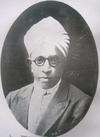T. S. S. Rajan
| Dr. Tiruvengimalai Sesha Sundara Rajan | |
|---|---|
 Portrait from the Haripura Congress Souvenir, 1938 | |
| Minister of Food and Public Health (Madras Presidency, later Madras state) | |
|
In office 1946–1951 | |
| Premier |
Tanguturi Prakasam, O. P. Ramaswamy Reddiyar |
| Minister of Public Health and Religious Endowments (Madras Presidency) | |
|
In office 14 July 1937 – 9 October 1939 | |
| Premier | C. Rajagopalachari |
| Governor | John Erskine, Lord Erskine |
| Member of the Imperial Legislative Council | |
|
In office 1934–1936 | |
| Governor General | Freeman Freeman-Thomas, 1st Marquess of Willingdon |
| Personal details | |
| Born |
1880 Srirangam, Madras Presidency |
| Died |
1953 (aged 73) Madras |
| Nationality | Indian |
| Political party | Indian National Congress |
| Alma mater |
St. Joseph College, Trichinopoly, Royapuram Medical School, Madras |
| Occupation | doctor, politician |
| Profession | doctor |
| Religion | Hindu |
Tiruvengimalai Sesha Sundara Rajan (1880–1953) was an Indian doctor, politician and freedom-fighter who served the Minister of Public Health and Religious Endowments in the Madras Presidency from 1937 to 1939.
Rajan was born in Srirangam in Trichinopoly district and studied medicine at Royapuram Medical School, Madras and England. He practised as a doctor in Burma and England and obtained his M.R.C.S. degree in 1911. In 1923, he set up his own clinic.
Rajan entered the Indian independence movement in 1919 and joined the Indian National Congress. He participated in the agitations against the Rowlatt Act and in the Vedaranyam Salt Satyagraha. He served as the President of the Tamil Nadu Congress Committee and as the Member of the Imperial Legislative Council of India from 1934 to 1936. From 1937 to 1939, he served as the Minister of Public Health in the Madras provincial government.
Early life
Sundararajan was born in Nagapattinam 1880. He had his early education from St. Joseph College, Trichinopoly and graduated in medicine from Royapuram Medical School, Madras.[1] Following his graduation, Rajan moved to Burma[1] and set up practice in Rangoon.[2]
In 1907, Rajan sailed to England to pursue his higher studies.[1][3] He obtained his M.R.C.S. degree in 1911 and worked in the Middlesex Hospital. He was an acclaimed surgeon and physician.[1]
Rajan returned to Burma soon after and practised till 1914, before returning to India. In 1923, he set up his own clinic called "Rajan Clinic".[1]
In the Indian independence movement
During his days in England, Rajan was a close associate of V. D. Savarkar and V. V. S. Aiyar and was a member of the India House. However, in May 1910, Rajan had a quarrel with Aiyar.[4] On his return to India in 1914, he met Rajagopalachari and joined the Indian National Congress. He participated in the agitations against the Rowlatt Act and was jailed for a year.[1] He also coordinated and organised the activities of the Khilafat Committee from 1920 to 1922 along with T. V. Swaminatha Sastri.[5][6]
Rajan served in a number of party posts in the Indian National Congress over the years. He served as the General Secretary of the Congress and as the President, and later, Secretary of the Tamil Nadu Congress Committee.[1] He also served as the President of the Civil, Social and Welfare League of Trichinopoly.[1]
Rajan participated in the Vedaranyam Salt Satyagraha organised by Rajaji and suffered imprisonment.[1] He was released in 1931 after having been in prison for eighteen months.[1] From 1932 to 1935, Rajan served as the President of the Tamil Nadu branch of the Harijan Sevak Sangh.[7]
In 1934, Rajan was elected to the Imperial Legislative Council of India and served till 1936, when he resigned owing to differences of opinion.[1] Rajan participated in the 1937 Madras provincial elections and was elected to the Madras Legislative Council.[1] He took the portfolios of public health and religious endowments in the Rajaji cabinet.[1]
Later years and death
In 1946, when the Congress was elected to power once again in Madras Presidency and Tanguturi Prakasam became Premier, Rajan was appointed Minister of Food and Public Health.[2] He served as minister till 1951.[8]
In 1953, Rajan had an operation for appendicitis. Shortly after the operation, he died on 14 December 1953 at the age of 73.[9]
Works
- T. S. S. Rajan (1946). Va. Ve. Cu. Iyer (in Tamil). Madras.
- T. S. S. Rajan (1947). Ninaivu Alaigal (Autobiography) (in Tamil). Madras.
Notes
- 1 2 3 4 5 6 7 8 9 10 11 12 13 "Biography:T. S. S. Rajan from the Haripura Congress Souvenir". Indian National Congress. 1938.
- 1 2 Baliga, B. S. (2000). Madras District Gazetteers. Superintendent, Govt. Press. p. 239.
- ↑ "Dr. Rajan passes away". The Hindu: This day that age. 28 October 2003.
- ↑ Chopra, Prabha; Prem Nath Chopra (1998). Indian Freedom Fighters Abroad: Secret British Intelligence Report. Criterion Publications. p. 139.
- ↑ Arnold, David (1977). The Congress in Tamilnad: nationalist politics in South India, 1919–1937. Manohar. p. 42. ISBN 0908070004, ISBN 978-0-908070-00-8.
- ↑ Baliga, B. S. (2000). Madras District Gazetteers. Superintendent, Govt. Press. p. 225.
- ↑ Mohan, Pullam Ethiraj (1993). Scheduled Castes, History of Elevation, Tamil Nadu, 1900–1955: History of Elevation, Tamil Nadu, 1900–1955. New Era Publications. p. 37.
- ↑ Jawaharlal Memorial Fund (1972). Selected Works of Jawaharlal Nehru. Orient Longman. p. 440.
- ↑ Lok Sabha Debates. Parliament of India. 1953. p. 4.
| Preceded by |
Secretary of the Indian National Congress | Succeeded by |
| Preceded by |
President of the Tamil Nadu Congress Committee | Succeeded by |
| Preceded by |
Secretary of the Tamil Nadu Congress Committee | Succeeded by |
| Preceded by 1937 |
Minister of Public Health and Religious Endowments 1939 |
Succeeded by Governor Rule |
| Preceded by 1946 |
Minister of Food and Public Health 1951 |
Succeeded by |
